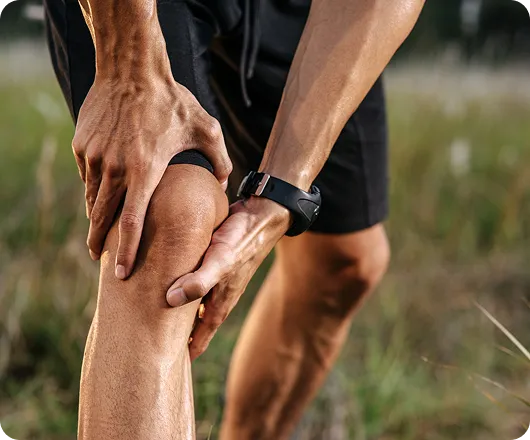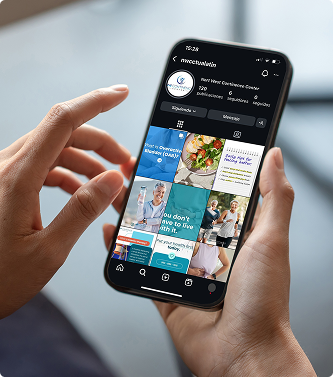Complex Regional Pain Syndrome (CRPS)
Personalized care for chronic nerve pain

What Is CRPS and How Does It Affect You?
Complex Regional Pain Syndrome (CRPS) is a chronic condition marked by intense, long-lasting pain -typically in the arms or legs- that may spread to other areas. It often follows an injury and includes symptoms like swelling, limited mobility, changes in skin color or temperature, and abnormal sweating.
The severity of CRPS can affect both sleep and emotional well-being. A multidisciplinary approach combining physical, emotional, and neurological care such as conservative therapies, non-opioid medications, and neuromodulation—can help manage symptoms and improve quality of life.
What Is CRPS and How Does It Affect You?
Complex Regional Pain Syndrome (CRPS) is a chronic condition marked by intense, long-lasting pain -typically in the arms or legs- that may spread to other areas. It often follows an injury and includes symptoms like swelling, limited mobility, changes in skin color or temperature, and abnormal sweating.
The severity of CRPS can affect both sleep and emotional well-being. A multidisciplinary approach combining physical, emotional, and neurological care such as conservative therapies, non-opioid medications, and neuromodulation can help manage symptoms and improve quality of life.

Causes of CRPS
CRPS often develops after a physical injury that triggers an abnormal and prolonged pain response. While the initial trauma may seem minor, the nervous system can become overly sensitive, leading to persistent symptoms. Common causes include:
Injuries to the limbs
Even mild trauma such as cuts, bruises, or bumps can, in rare cases, lead to CRPS. The condition typically starts at the site of injury.
Fractures, sprains, or strains
Broken bones or soft tissue injuries may disrupt normal nerve function and cause pain that continues long after the injury heals.
Surgery or limb immobilization
Surgical procedures or extended periods of immobilization (like wearing a cast) can sometimes trigger CRPS by affecting circulation and nerve signals.
Nerve damage or compression
Underlying spinal conditions such as lumbar spinal stenosis (LSS) or a herniated disc may irritate or compress nerves, setting off a CRPS-like response in the affected limb.
Symptoms of CRPS
While pain after an injury is expected, pain that is disproportionate or unusually persistent may indicate CRPS. Other signs include:
✔ Ongoing, severe pain in the affected limb
✔ Swelling and changes in skin color, temperature, or texture
✔ Joint stiffness and muscle weakness
✔ Limited mobility
✔ Heightened sensitivity to touch or cold
✔ Abnormal sweating
✔ Changes in hair and nail growth
Stages of CRPS
As a progressive condition, CRPS may evolve through different phases:
Acute phase: Symptoms last between 1 to 3 months
Dystrophic stage: Symptoms persist for 3 to 6 months
Atrophic phase: Symptoms continue beyond six months
Multidisciplinary Treatment for CRPS
CRPS requires a multifaceted treatment plan that may include neuromodulation procedures, medications, and supportive therapies.
Neuromodulation
Neuromodulation works by altering nerve activity to reduce pain signals sent to the brain. Common techniques include:
✔ Peripheral nerve stimulation: Electrical impulses target peripheral nerves around the spine
✔ Nerve blocks: Temporarily numb nerves to interrupt pain signals
✔ Spinal cord stimulation: Delivers electrical impulses to the spine to change how pain is perceived
✔ TENS (Transcutaneous Electrical Nerve Stimulation): Uses low-level electrical stimulation to reduce pain and increase circulation
Injections
Injections offer quick relief and can significantly reduce CRPS symptoms. These include:
✔ Nerve-blocking injections: Block pain signal transmission
✔ Sympathetic ganglion blocks: Reduce pain and inflammation
✔ Epidural steroid injections: Lower nerve inflammation
Non-Opioid Medications
To avoid dependency and side effects, non-opioid medications are often preferred. Options may include:
✔ Nonsteroidal anti-inflammatory drugs (NSAIDs)
✔ Anticonvulsants
✔ Antidepressants
✔ Muscle relaxants
Therapies & Lifestyle Changes
A comprehensive care plan often involves multiple therapies and lifestyle modifications to address both physical symptoms and emotional impact:
✔ Physical therapy: Helps restore movement and reduce pain; may include massage, acupuncture, or chiropractic care
✔ Occupational therapy: Supports daily functioning using adaptive tools and pain management techniques
✔ Psychotherapy: Addresses the emotional burden and mental health effects of CRPS
✔ Stress management: Breathing and relaxation techniques can help reduce pain perception Sleep hygiene: Good sleep habits can lessen fatigue and discomfort
✔ Healthy lifestyle: Regular low-impact exercise, a nutritious diet, and avoiding smoking and alcohol contribute to overall improvement

Care That’s Close to Home
We offer care from two convenient clinic locations, making it easy to access expert medical support close to home.
Each facility is designed to provide a welcoming, safe, and efficient environment equipped with advanced technology and supported by a compassionate team dedicated to your well being.
Care That’s Close to Home
We offer care from two convenient clinic locations, making it easy to access expert medical support close to home.
Each facility is designed to provide a welcoming, safe, and efficient environment equipped with advanced technology and supported by a compassionate team dedicated to your well being.

Why Choose Spinal Diagnostics?
Patients choose Spinal Diagnostics for our comprehensive approach, accurate diagnostics, and compassionate care. We stay at the forefront of interventional procedures and are committed to improving your quality of life without opioids or invasive surgeries.
Proven Medical Expertise
We bring years of clinical experience in pain management and interventional procedures.
Constant Innovation
We use the latest techniques and technology to ensure safe, effective treatment.
Compassionate Care
We listen, understand, and treat every patient with empathy and respect.
Personalized Plans
Each treatment is tailored to your condition, goals, and lifestyle.
Explore the treatments that bring real relief.
Learn how our non-invasive solutions and personalized plans can help you feel better, faster.
Explore the treatments that bring real relief.
Learn how our non-invasive solutions and personalized plans can help you feel better, faster.


